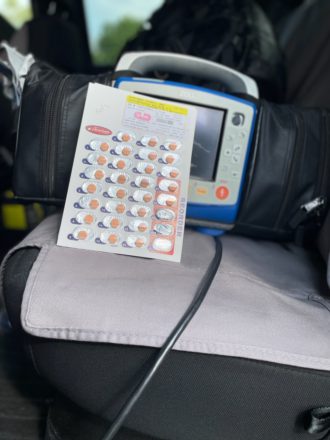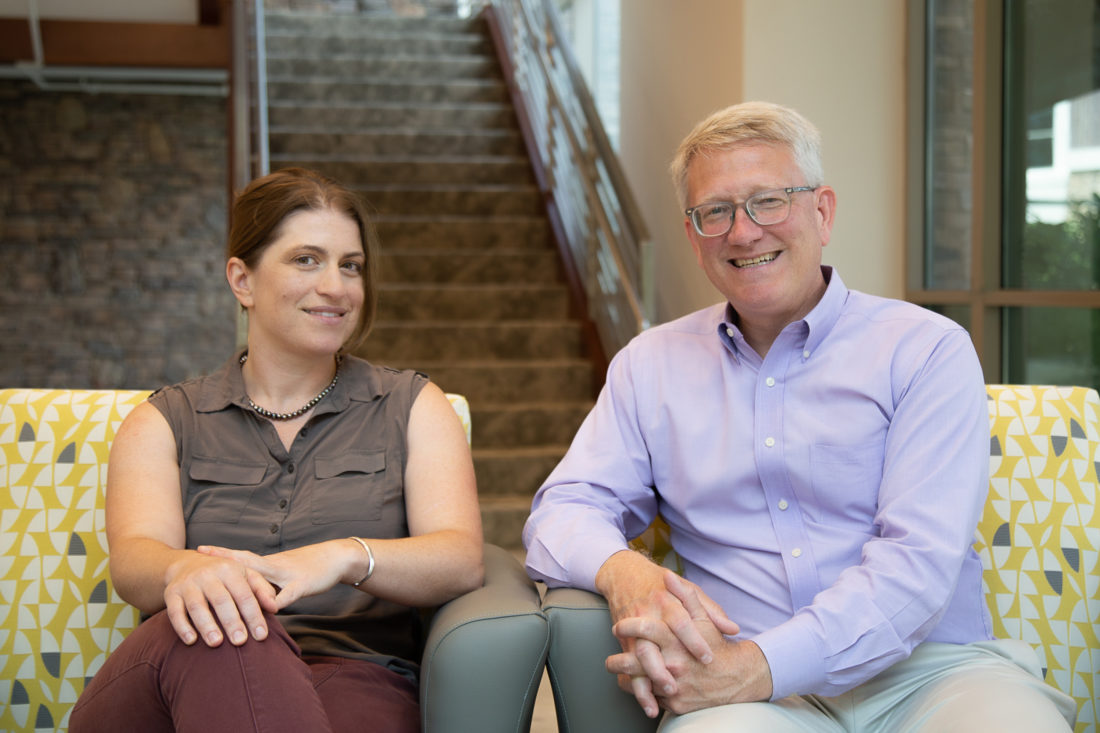In 2017, Josh Hampton started taking a medication that helped change the course of his life.
He had served 19 months in state prison for felony drug possession. While attending required intensive outpatient classes after his release, a clinician advised Hampton to initiate medication-assisted treatment, or MAT, for opioid addiction. Medications such as buprenorphine, which don’t produce euphoria, can help those in recovery by reducing the cravings that often lead people back to opioids.
“[My doctor] felt like I was at a high chance for relapse,” he says. At the time, Hampton, then a new father, “didn’t want to take any chances.” For a year and a half, he flourished in recovery.
According to a 2016 article in the Journal of Substance Abuse Treatment, “Medication-assisted treatment … is the gold standard in evidence-based treatment for [opioid use disorder] with survival and treatment retention rates up to seven times that of drug-free modalities.” Evidence shows that combining MAT with behavioral therapy helps people sustain recovery. Hampton says MAT allowed him to “feel normal again” and experience what life could be like without going through withdrawals.
But his access to MAT was tied to attending the required intensive outpatient classes. He struggled to follow through while also working full time. So, he stopped MAT and eventually started using again. The classes were a “barrier … but I also did make a conscious choice to go back and use,” he says.
In 2022, determined to pursue recovery again, Hampton returned to MAT. “I sought it out myself this last time,” he says, initiating MAT at October Road before transitioning to treatment at Mountain Area Health Education Center.
Health care providers know that people like Hampton need a reason to pursue recovery, and one opportunity often comes immediately after an overdose reversal. “Most people might be more ready to consider getting into treatment if they’ve just had a really scary experience where they almost died,” says Dr. Genevieve Verrastro, a MAHEC family medicine physician. “We think both from a pharmacological point of view and from a psychological point of view, this is a good time to intervene.”
Research in emergency room and jail populations shows a person is most at risk for an opioid overdose after a previous one has just been reversed. But until recently, people who had overdosed and were brought to Mission Hospital’s emergency department didn’t initiate MAT and weren’t linked to further services upon leaving, says Wyatt Chocklett, Mission’s ER chief operating officer.
However, a new pilot program that started this summer makes the connection easier to navigate by initiating MAT in Mission’s ER and coordinating a follow-up appointment with MAHEC.
Filling the gaps
Before the pilot’s launch, Claire Hubbard, lead paramedic with Buncombe County Emergency Medical Services, says paramedics sometimes administered buprenorphine outside the ER. Occasionally, a Mission employee would let BCEMS know when a patient who wanted to begin MAT left the ER. But more often, the community paramedicine program would seek out these individuals around town, Hubbard says. After initial contact, BCEMS could continue to administer MAT in the field for up to five days and informally refer clients to MAT providers; after that, the patient would ideally have an appointment with a health care provider who could write a prescription for MAT.
According to Chocklett, preliminary data shows that roughly 60% of patients who receive a first appointment for MAT experience a positive retention rate. “In other words, they stay with the program at the one-year mark,” he says. Obtaining an appointment with an addiction specialist, he stresses, is critical for a patient’s “path to recovery.”

Mission’s ER is experiencing the same impacts of the opioid epidemic as ERs nationwide, Chocklett continues. (Mission does not have a system for calculating its total number of overdose cases, says spokesperson Nancy Lindell.)
Buncombe County had a rate of 35 opioid deaths per 100,000 people from 2017-21, according to the most recent data provided by the N.C. Department of Health and Human Services Division of Public Health. The county rate surpassed the statewide rate of 23 opioid deaths per 100,000 people during that same time.
Now with the pilot program in place, patients at Mission’s ER undergo screening for possible MAT candidacy using the clinical opioid withdrawal scale, or COWS, explains Chocklett. However, the main criterion is a willingness to try treatment. Hampton agrees, saying, “MAT alone was not going to get me where I need to be. I had to put in the work to recover.”
A Mission ER physician will initiate MAT with a first dosage of buprenorphine and a prescription to last a few days. Mission’s ER nurses and social workers then connect that patient to a follow-up appointment with an addiction specialist at MAHEC. Dr. Blake Fagan, a family medicine physician at MAHEC, says that his clinic is keeping several appointments open daily for these individuals.
However, visiting the ER following an overdose isn’t the only way to be eligible for MAT. Chocklett says patients with an opioid addiction who have come to the ER with other conditions can be eligible as well. In fact, he says, one goal of expanding access to MAT is to prevent potentially deadly overdoses from being the primary pathway to pursuing recovery.
Building a backbone
Verrastro, who leads the pilot program for MAHEC, Fagan and other health care providers had to address several logistical issues before launching the pilot. The first was a concern among some hospitals that “if we start providing buprenorphine to people in the ER, then all of the people who have a use disorder are going to come in, and our ER is already overwhelmed,’” Fagan summarizes.
Research about MAT initiation in ERs didn’t validate this concern, Fagan notes. And he thinks it unlikely that a person, especially one experiencing opioid withdrawal, would wait in a crowded ER “for six to eight hours to get — possibly — one dose” of MAT.
Hospitals eventually came to accept that their ERs would not become ad hoc addiction clinics, Fagan says. But the second problem was the need for enough trained health care providers with available appointments who could provide continued treatment.
Fagan recalls how in 2013, MAHEC had only a “handful” of physicians who could initiate MAT, so a patient might wait 10-17 days for an appointment. “We had a huge no-show rate,” he says. He surmises that before patients could get to their health care providers, painful opioid withdrawals led them to start using again.
In 2022, the federal government passed the MAT Act, with input from Fagan. Now any health care provider holding an active license with the U.S. Drug Enforcement Administration — because buprenorphine is a Schedule 3 drug — can write a prescription to start a patient on buprenorphine.
He estimates over 200 clinicians at MAHEC can write prescriptions for buprenorphine, including the entire family medicine, psychiatry and OB/GYN departments. With the volume of trained professionals increased, currently “our goal is to see any patient in 24-48 hours [following an overdose],” Fagan says. “We’re pretty good on that.”
Grants also allow MAHEC to help people who have just gotten out of incarceration or just gotten off Medicaid to continue MAT, explains Verrastro. And to further expand access, MAHEC trained health care providers at all federally qualified health centers in North Carolina, which treat patients regardless of their ability to pay, to administer MAT.
“We built that backbone,” Fagan says, pointing out that now physicians in Mission ER can start patients on buprenorphine and then direct them to those health centers to continue treatment.
Referrals come from ERs as part of the pilot, as well as from BCEMS’ Post-Overdose Response Team, or PORT, which began initiating MAT last year. (In 2020, the Buncombe County Detention Center also began offering MAT to people who are incarcerated.)
Coordination among hospitals
Fagan estimates North Carolina has over 100 emergency departments, but only “a couple dozen” have protocols in place to initiate MAT. Mission is among eight hospitals, including Blue Ridge Hospital in Spruce Pine, chosen to participate in the pilot to coordinate MAT initiation in ERs.
The N.C. Healthcare Foundation, which is the nonprofit arm of the N.C. Healthcare Association, coordinated the pilot, and it is funded by the N.C. Department of Health and Human Services Division of Public Health, Injury and Violence Prevention Branch. Outcomes will be available later this month.
The pilot coincides with an expansion of the community paramedics program within the BCEMS, which is funded by Buncombe County’s portion of opioid relief settlement. (BCEMS’ community paramedicine team began in 2020 to address widespread substance use in the county as well as health impacts of poverty. It debuted the PORT in 2021.)
“Part of the aim of our expansion is to coordinate with the hospital so that we can create a safety net for patients being discharged,” explains lead paramedic Hubbard. She notes that some patients are not discharged from the ER and leave against medical advice; community paramedics will initiate MAT for them, too.
BCEMS’ expansion adds three paramedics, three supervisors and Dr. Shuchin Shukla, former opioid crisis educator with MAHEC, as a physician consultant on public health efforts to expand access to medications for opioid use disorder.
Success story
Hampton thinks that as fentanyl becomes more pervasive and deadly “more people should be open to the idea” that MAT can work. “For a lot of people [MAT] greatly increases their chance of success and recovery.”
Nowadays, Hampton attends A-B Tech full time, working toward an associate degree. Although he is no longer taking MAT, Hampton has been maintaining his recovery with the help of health care providers from MAHEC. The rewards of recovery, he notes, are many. Hampton works as a certified MAT peer navigator for Sunrise Community for Recovery and Wellness, assisting those formerly incarcerated who want to continue treatment.
But most importantly, Hampton says, “I’m an active father.”
He and his daughter watch old episodes of “The Flintstones” and “The Jetsons” together, and she loves roller skating. “I’m in my daughter’s life again,” he says. “I’m able to be there for her.”




Before you comment
The comments section is here to provide a platform for civil dialogue on the issues we face together as a local community. Xpress is committed to offering this platform for all voices, but when the tone of the discussion gets nasty or strays off topic, we believe many people choose not to participate. Xpress editors are determined to moderate comments to ensure a constructive interchange is maintained. All comments judged not to be in keeping with the spirit of civil discourse will be removed and repeat violators will be banned. See here for our terms of service. Thank you for being part of this effort to promote respectful discussion.